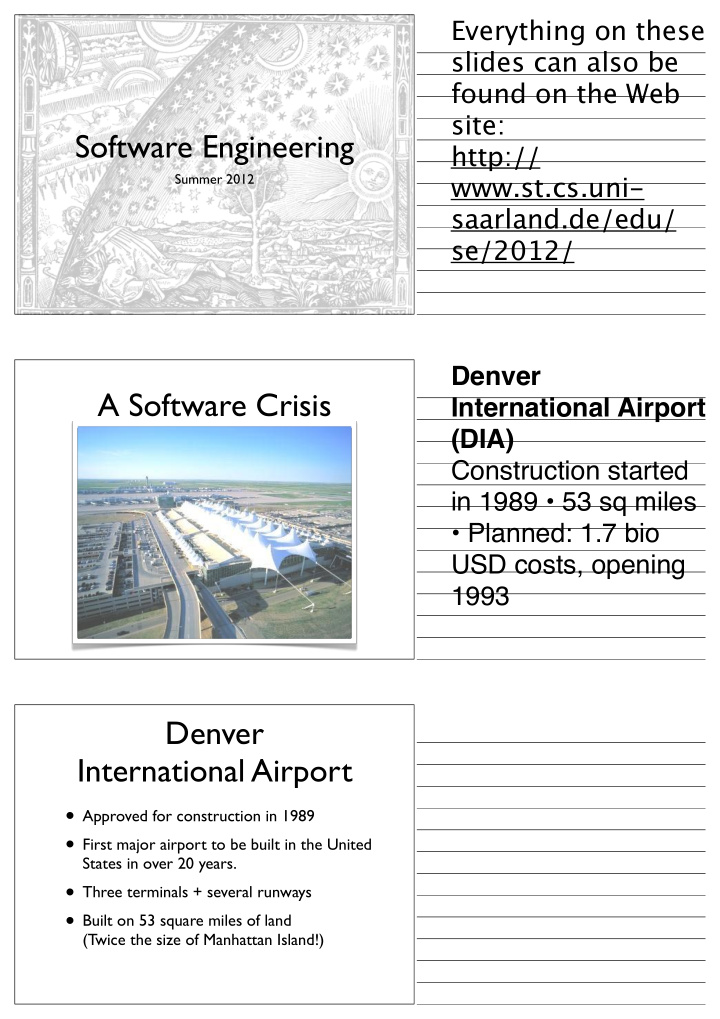



Everything on these slides can also be found on the Web site: Software Engineering http:// Summer 2012 www.st.cs.uni- saarland.de/edu/ se/2012/ Denver A Software Crisis International Airport (DIA) Construction started in 1989 • 53 sq miles • Planned: 1.7 bio USD costs, opening 1993 Denver International Airport • Approved for construction in 1989 • First major airport to be built in the United States in over 20 years. • Three terminals + several runways • Built on 53 square miles of land (T wice the size of Manhattan Island!)
BAE Contract • Original assumption: Every company builds its own baggage transport system • United (70% Denver traffic) was the only to begin planning; contract with BAE • First fully automated baggage system • Later, Denver airport extended contract to entire airport – three times original size The Scope • 20 miles of track • 6 miles of conveyor belts • 56 laser arrays that read bar coded tags • 400 frequency readers • 3,100 standard size baggage ‘T elecars’ • 450 6.5 ft by 4 ft oversize cars • 55 separate computers The System
The Timeframe • BAE started work 17 months before scheduled opening October 31, 2003 • In Munich (similar system), engineers had spent two years just testing the system (with 24/7 operation six months before the airport opened) More Risks • Most of buildings were already done, so BAE had to accommodate system (sharp turns, narrow corridors…) • BAE paid little attention to German sister project and devised system from scratch • Little communication within BAE While all of the Final Blunder previous blunders contributed to the failure of the system, the worst • The decision to broadcast the preliminary mistake was still test of the “revolutionary” new baggage system on national television yet to come. It was a decision so terrible, so foolish, so absolutely
What camera crews depicted was truly a disaster; carts jammed together, damaged luggage everywhere, some bags literally split in half, and the tattered remains of clothing strewn A Disaster • Carts jammed together • Damaged luggage everywhere, some bags literally split in half • Tattered remains of clothing strewn about caused subsequent carts to derail • Half the luggage that survived the ordeal ended up at the wrong terminal More Issues • Carts got stuck in narrow corridors • Wind blew light baggage from carts • 5% of the labels were read correctly • Normal network load was 95%
Complexity: Empty Carts • Empty carts need to go where they are needed • Cart has to be at its “cannon” at the right moment • Lanes have limited length ➔ traffic jam • All controlled by single central system Consequences • Airport opening delayed four times – overall, sixteen months late • New engineering firm • split system in three (one per terminal) • implemented manual backup system • BAE got bankrupt • Overall damage: 1.3 bln USD This and other laws Glass’ Law are found in Endres/Rombach: Handbook of Software and Requirement deficiencies Systems are the prime source of project failures. Engineering. Evidence: Denver airport case study and two more
http:// Chaos Report www.standishgroup .com • 31% of projects were aborted prior to completion • in small (large) development companies, only 16% (9%) of all projects were completed within projected budget and time limits Survey by the Standish Group, 1994 – 350 companies with >8000 software projects 16% of all projects successful Project Success 53% operational, but less than successful successful operational cancelled 31% cancelled 16% 31% 53% Survey by PC week, 1995: 365 information systems professionals on success of software development projects http://www.tagesanzeiger.ch/digital/ computer/13-Softwarefehler-die-zu- More Examples Katastrophen-fuehrten/story/21703807 • Mariner 1 (1962) • Stock crash (1987) Rocket crash due to missing dash Dow Jones loses 22% in one day • Eole 1 (1971) • Vincennes (1988) 72 weather balloons get wrong cmd Passenger jet mistaken to be F-14 • Nimbus 7 (1978) • Patriot (1991) Satellite misses ozone hole for 6 yrs Misses to shoot down Iraqi Scud • HMS Sheffield (1982) • Climate Orbiter (1999) Exocet rocket id’ed as “friend” Confuses metrics and imperial • Stanislaw Petrow (1983) • US Blackout (2003) Russia detects global nuclear attack 50 mln affected for 5 days • Therac 25 (1985) • Social support (2004) Radiation overdose kills six No money for millions
Challenges • Why does it take so long to get software finished? • Why are the development costs so high? • Why can’t we find all errors? • Why do we spend so much time and effort maintaining existing programs? • Why is it difficult to measure progress? T opics • Requirements Engineering • Software Specification • Software Design and Architecture • Software Quality Assurance • Software Maintenance and Evolution • Software Project Management
Your Lecturers • Andreas Zeller • Lecture Tue/Thu 08:30–10:00 HS 002 • Irregular timing (see Web page) Your Tutors • Florian Gross (coordinator) • Konrad Jamrozik (senior tutor) • Aliaksandr Talaika • Olga Mykytiuk • Max-Ferdinand Suffel • Krishna Narasimhan • Daria Gaidar • Sabina Glowacka • Mykola Havrikov • Marie-Therese Walter • Frederik Leonhardt • Souza N. Windiartono Books
Exam JULY 27 (+ extra exam mid September) Projects • SW Engineering is best learned by doing (There is no “theory of software engineering”) • Therefore, projects make up 2/3 of course Projects
Client T eam Tutor
Supervision Honor Project Details • Non-trivial piece of software • Suggested by client (a CS member) • Client is busy (spends max 15 hrs total) • Client is vague (on purpose)
Deliverables • Full set of requirements • User interface design • Architecture design • Project plan • Prototype Grading Exam Project • Need to pass both exam and project to pass • Project grades 67% based on group 33% performance (with bonus for individuals) http:// Web Site www.st.cs.uni- saarland.de/edu/ se/2012/
Sign up! Summary
Recommend
More recommend